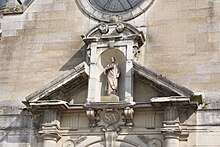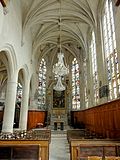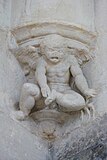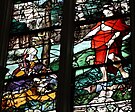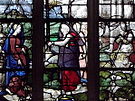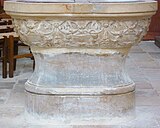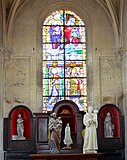St-Acceul (Écouen)
The Catholic parish church of Saint-Acceul in Écouen , a parish in the Val-d'Oise department in the French region of Île-de-France , was built in several construction phases from the 16th to the 19th centuries on the site of a previous church. The church is worth seeing because of its stained glass windows from the Renaissance , which have been completely preserved. In 1840 the church was added to the list of architectural monuments in France as Monument historique .
Patronage
The church of Saint-Acceul in Écouen is the only church with this patronage . The church was first mentioned under this name in the 11th century, when the lords of Montmorency made the church of Écouen subordinate to the Saint-Martin-des-Champs Abbey in Paris . The church was probably originally dedicated to St. Acheolus (fr. Acheul ), a martyr venerated in Amiens . Acheolus was later merged with the person of St. Andeolus , whose bones are kept in the church of Saint-Andéol in Bourg-Saint-Andéol . During the crusades against the Albigensians , Mathieu II. De Montmorency brought back a relic of St. Andeolus, who had evangelized in Vivarais and suffered the martyrdom of being beheaded by the sword.
history
Nothing is known of the previous church. In 1536 Anne de Montmorency , raised to the rank of Konnetabel in 1538 and, since 1551, Duke of Montmorency , had a new choir built in the Flamboyant Gothic style. Two years later, the medieval castle next to the church belonging to his possessions was demolished and a new castle built in the Renaissance style. Charles Billart is credited with directing construction on the church's choir, the first phase of which was completed around 1545. He was succeeded by Jean Bullant , who was buried in the church in 1578. Construction work was stopped as early as 1554 due to lack of money and the wars against the Huguenots . Only in 1709 was the new nave with the support of Henri III. Jules de Bourbon, Prince de Condé and his wife Anna Henriette von Pfalz-Simmern completed. The church was given its west facade in neo -renaissance style in 1852 by the architect Pierre-Joseph Garrez.
architecture
Exterior construction
The choir is broken up by tall tracery windows. It is structured by buttresses decorated with crabs and mythical creatures. The aedicula in the blown gable above the portal of the west facade contains a sculpture of the patron saint of the church, who holds a saw in his hand as a sign of his martyrdom. On the north side of the nave, which does not reach the height of the choir, rises the massive, square bell tower, which was not completed. It has a bell on which the coat of arms and the motto of Anne de Montmorency are engraved. It was cast in 1554, weighs 1,300 kilograms and is one of the oldest bells in the department.
inner space
The church consists of a main nave and a north aisle. The nave is covered with a simple wooden ceiling. The choir has a ribbed vault with splendid keystones on which a fruit basket and foliage are depicted. The consoles on which the vault ribs rest are decorated with acanthus or depictions of angels carrying the instruments of Christ's passion . Two consoles in the nave are decorated with angel putti , one is cutting a fruit, another is shown as a thorn puller .
Renaissance window
The oldest lead glass windows come from the first phase of construction of the church and are dated with the year 1544 and 1545 respectively. The last two Renaissance windows, donated by Henri I. de Montmorency and Antoinette de Lamark, were installed in 1587.
- Middle choir window (window 0) and window of the Marienkapelle (window 11)
|
The two upper lancets depict Christ and Mary, the risen Christ appears to his mother Mary. The lower panes were removed at the beginning of the 18th century and reinstalled in the Marienkapelle under the tower. The lower part is dedicated to two martyrs, the patron saint of the Church, Saint Acceul, who holds a saw in his hand, and his companion, Saint Accius, who is represented with a drill. The representation of the Madonna on the crescent moon in the upper left part is borrowed from the Apocalypse , the scene on the right is reminiscent of the meeting of Anna and Joachim at the Golden Gate. |
- Window by Anne de Montmorency (Window 1)
|
The window shows Anne de Montmorency kneeling next to his five sons and clasping his hands in prayer. The figure about Anne de Montmorency is interpreted as Emperor Henry II . The sons are entrusted to the protection of St. Stephen , who is holding a book with stones on it as a sign of his martyrdom. The scourging and mocking of Jesus are shown in the upper scenes. |
- Window of the Magdalena of Savoy (Window 2)
|
Magdalena of Savoy was the wife of Anne de Montmorency. She is shown with four of her seven daughters, with St. Mary Magdalene and St. Martha in the background . On the middle panes Mary Magdalene the risen Christ appears, who presents himself to her as a gardener ( Noli me tangere ). The upper panes depict Jesus carrying the cross and meeting his mother Mary. |
- Window of the Nativity and Adoration of the Shepherds (Window 3)
|
The window on the east wall of the side aisle depicts the birth of Christ and the Adoration of the Shepherds in the upper area, and the Adoration of the Magi in the lower area. |
- Window of the Cardinal of Châtillon (Window 4)
|
The window bears the year 1545. It was donated by Odet de Coligny , Cardinal of Châtillon and later leader of the Huguenots. On the lower level the cardinal is shown, on his right the risen Christ and on his left the apostle Paul. The parable of the lost sheep is told in the middle level and the fall of man at the top. |
- Annunciation and Visitation Window (Window 5)
|
The scene of the Annunciation is shown on the upper panes. The room, in the middle of which a window opens, is equipped with many details. The Archangel Gabriel appears on the left, holding a banner in his hands. Maria is kneeling on the right. In front of her is a vase with lilies, the symbol of her virginity. The lower panes represent the Visitation. Maria and Elisabeth wear splendid, pleated robes, both are accompanied by two servants. In the background, Zacharias sits in front of his house, which looks like an ancient temple. |
- Window by Henri de Montmorency and Antoinette de Lamark (windows 6 and 8)
|
The two windows were donated to the church in 1587 by Henri I de Montmorency and his first wife Antoinette de Lamark. Henry of Montmorency is represented with St. Hadrian, another scene shows a descent from the cross. Antoinette de Lamark kneels with her daughters in front of two saints next to a Madonna pierced by seven swords. |
- Window of the Assumption of Mary (Window 7)
The window of the Assumption of Mary is in the north aisle. The death of Mary is depicted on the middle level. The scene takes place in a splendidly furnished room, which opens into a fantasy landscape in the upper right field. At the bottom left a donor kneels, behind him is the French King Louis the Saint.
Furnishing
- The Altar of Mary from the 17th century contains a Madonna and Child, which is dated to the late 14th century.
- The sculptural group of the Annunciation scene in the Lady Chapel dates from the mid-16th century and was originally located in a chapel in the forest of Écouen , which was built for Anne de Montmorency and destroyed during the French Revolution .
- The oval baptismal font from the late 16th century is decorated with arabesques, putti and lion heads.
- The painting on the high altar is a copy of Raphael's Transfiguration of Christ . The original is in the Vatican Pinacoteca .
- A clavicle bone of St. Andeolus, which was brought from Bourg-Saint-Andéol to Écouen around 1700, is kept in a reliquary from 1730.
literature
- Jean-Marie Pérouse de Montclos (ed.): Le Guide du Patrimoine. Île-de-France . Hachette, 2nd edition, Paris 1994, ISBN 2-01-016811-9 , pp. 234-235.
- Dominique Foussard, Charles Huet, Mathieu Lours: Églises du Val-d'Oise. Pays de France, Vallée de Montmorency . Société d'Histoire et d'Archéologie de Gonesse et du Pays de France, 2nd edition, Gonesse 2011, ISBN 978-2-9531554-2-6 , pp. 95-103.
- Mathieu Lours: Saint-Acceul d'Écouen. Une cage de verre en Pays de France .
- Le Patrimoine des Communes du Val-d'Oise . Flohic Éditions, Vol. 1, Paris 1999, ISBN 2-84234-056-6 , pp. 203-206.
Web links
- Église Saint-Acceul Office de Tourisme d'Écouen, accessed on January 5, 2014 (French)
- Église Saint-Acceul in the Base Mérimée of the French Ministry of Culture (French)
- Verrières de choeur et de la nef in the Base Palissy of the French Ministry of Culture (French)
Individual evidence
- ↑ Acheolus Amiens Ecumenical Holy encyclopedia , accessed on 27 December 2013
- ^ Andeolus of Smyrna Ecumenical Lexicon of Saints , accessed December 27, 2013
- ↑ Vierge à l'Enfant in the Base Palissy of the French Ministry of Culture (French)
- ↑ Fonts baptismaux in the Base Palissy of the French Ministry of Culture (French)
Coordinates: 49 ° 1 ′ 4.9 ″ N , 2 ° 22 ′ 47.3 ″ E


